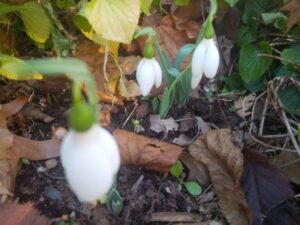 It has been a long winter in this part of the world. After several “open” winters with little snow and relatively warm temperatures, we have been treated to cold weather, often coupled with high winds, and repeated snowy days. Everything is relative, of course, and compared with parts of Minnesota, our snow amounts have been minimal. Still, the repeated cold, windy onslaughts have been enough to make me want to roll up in a down comforter and sleep until sometime around the Ides of March.
It has been a long winter in this part of the world. After several “open” winters with little snow and relatively warm temperatures, we have been treated to cold weather, often coupled with high winds, and repeated snowy days. Everything is relative, of course, and compared with parts of Minnesota, our snow amounts have been minimal. Still, the repeated cold, windy onslaughts have been enough to make me want to roll up in a down comforter and sleep until sometime around the Ides of March.
Since I have to get up and work for a living, not to mention carrying on with life’s other irksome chores, like paying bills and changing light bulbs, I look for signs of spring. Today, with a dusting of snow from last night, plus the usual window-shaking gusts of wind, I go out in the garden to check for signs of hope.
The edges of the groundhog hole by the garage are covered with snow, meaning that his Royal Fatness is emulating his relative, Punxsutawney Phil, and slumbering peacefully for another few weeks at least. There are no signs of squirrels either, though I know that they will be out and about the first day that the temperature rises to 40 degrees.
I look longingly at the mophead hydrangeas—Hydrangea macrophylla—which still bear their desiccated flowerheads from last summer. I leave the flowerheads on for two reasons—laziness and insulation. Some pundits suggest that the blowsy dried globes on the plants offer at least a bit of protection from cold winds. Time will tell, but for now, I give thanks that these old-fashioned varieties have not suffered through the thawing-freezing cycle that causes nascent buds to swell hopefully and then shrivel miserably, presaging a lack of blooms when late May finally rolls around.
Next to one of the hydrangeas is a winter-flowering jasmine or Jasminum nudiflorum, and it offers the first sign of things to come. While no bright yellow flowers are visible, the buds are plump enough to signify that they will open up the minute the wind dies down. One neighbor, whose jasmines grow in a protected spot against a south-facing wall, already has a few of the forsythia-like flowers. I will have to wait just a bit, but those buds offer encouragement cloaked in reddish brown sepals.
I saw snowdrop tips last week in front of one of the hydrangeas, but now the spot is covered with snow. I know that the snowdrops underneath are fine, waiting to work their way through that snow and create an early spring scene. For now though, they remain demurely hidden.
The real sign of hope is in the upper back garden and it goes by an awful common name—“stinking hellebore”—which is only slightly mitigated by its Latin name, Helleborus foetidus. On first acquaintance, the hellebores don’t stink at all. You have to crush the leaves to notice their foul odor. What is most apparent right now is the fact that the plants are standing tall among the snowy remnants. The biggest one is erect at 12 inches in height, with the flower cluster at the top looking like a miniature artichoke, surrounded by a slightly rakish-looking collar of leaves. The main stem is thick, and almost woody, supporting six to eight-inch leaf stems or arching petioles that end in palmate leaves. Each individual leaf is composed of thin leaflets that look almost like green fingers. Those fingers, which have been on the plant since last year, look at little shopworn at the moment, and as the weather warms, they will be replaced by fresh new growth. Long before that happens, and, in fact, in the next week or so, those “artichokes” will open out into clusters of pale green, buttercup-like flowers that will last on the plants until warmer weather returns and the first daffodils start to bloom.
I cut one stem of the hellebore to bring inside, and I am hoping that my small act of encouragement will persuade the flower buds to open ahead of their outdoor relatives.
Sitting in a glass on my desk, the stinking hellebore looks a little ungainly, but to my winter-starved eyes, it is beautiful. Beautiful enough, at least, to stave off a return to the sleepy safety of the down comforter.
